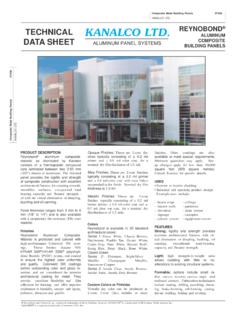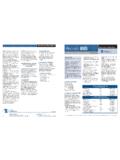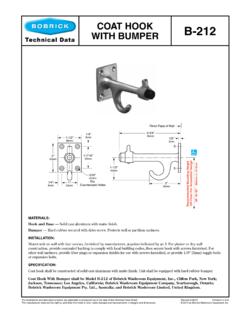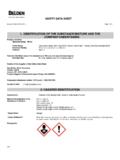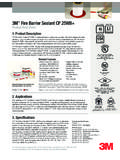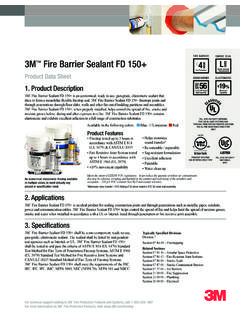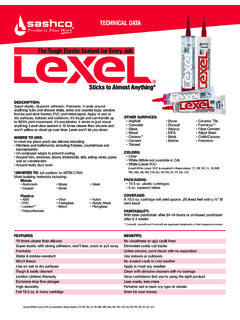Transcription of SAFETY DATA SHEET - Redland Brick
1 SAFETY data SHEET . Latest Revision: 05-15-2015. SECTION 1 - IDENTIFICATION OF THE SUBSTANCE/MIXTURE AND THE COMPANY/UNDERTAKING. Product Identifier: Material Name: Brick Trade Name: Clay and/or Shale Brick ; Face Brick ; Pavers; Red Shale/Fireclay Chemical Resistant Brick Chemical Family: Predominately Aluminum Silicates Formula: Mixture Relevant Identified Uses of the Substance or Mixture and Uses Advised Against Intended Use: Building material used for structural support. Details of the Supplier of the SAFETY data SHEET Redland Brick Inc. Product Support/ Technical Services Phone: 301-223-7700. 15718 Clear Spring Road, P O Box 160 Emergency Phone number: (24 hrs.): 301-223-7700. Williamsport, MD 21795 Contact E-Mail: SECTION 2 - HAZARD(S) IDENTIFICATION. Appearance: Granular Brick -shaped solid; comes in wide range of colors Hazard Classification of the Skin irritation 2 Carcinogenicity 1A. Substance or Mixture: Eye irritation 2A Specific target organ toxicity-Single exposure 3.
2 Skin sensitization 1B Specific target organ toxicity-Repeated exposure 1. Signal Word: DANGER. Hazard Statement: Brick dust may contain crystalline silica, a chemical that has been determined by certain agencies to cause cancer. See Section 11 for more information on health hazards. Pictograms: Precautionary Statement: Limit inhalation of clay dust. Do not eat, drink, or smoke when using this product. Wash hands thoroughly after handling. Contaminated work clothing must not be allowed out of the workplace Obtain special instructions before use. Do not handle until all SAFETY precautions have been read and understood. Wear protective gloves/protective clothing/eye protection/ face protection. Use only outdoors or in well ventilated area. Response: If exposed or concerned: Get medical advice/attention. If skin rash occurs: Get medical advice/. attention. If in eyes: Rinse cautiously with water for several minutes. Remove contact lenses, if present and easy to do.
3 Continue rinsing. If eye irritation persists: Get medical advice/attention. If Brick dust is inhaled: Remove person to fresh air and keep comfortable for breathing. Call poison center/doctor if you feel unwell. Storage: Not Applicable Disposal: Dispose of unused or unwanted Brick products in accordance with all local, regional, national and international regulations. SECTION 3 - COMPOSITION/INFORMATION ON INGREDIENTS. INGREDIENTS CAS NO. % WEIGHT ADDITIONAL INFORMATION: Aluminum Silicates Various 75-85 The listed chemistries are provided for industrial hygiene and Quartz 14808-60-7 Varies environmental purposes and are not intended to represent Iron Compounds Various 0-5 product specification. This information has been compiled Calcium Compounds Various 0-12 from data believed to be reliable. Elements such as aluminum, Manganese Compounds Various 0-3 arsenic, boron, barium, chromium, cobalt, copper, lead, nickel, Magnesium Compounds Various 0-3 molybdenum, tin, titanium, vanadium and zirconium may be Zinc Compounds 1314-13-2 0-10 present in trace amounts.
4 Brick products as shipped to not Iron Chromite 1308-31-2 0-3 present an exposure hazard. SECTION 4 - FIRST AID MEASURES. Description of First Aid Measures Eye Contact: Flush with running water. Obtain medical assistance if irritation continues. Skin Contact: Wash with soap and water. If allergic reaction causes a rash that does not heal within a few days consult a physician. Treat abrasions as any other scrape or cut with disinfectants and bandages. Redland Brick Inc. Page 1 of 3 SAFETY data SHEET 5-2015. SECTION 4 - FIRST AID MEASURES. Ingestion: None (no known acute effects). Inhalation: Remove from exposure to airborne particulates. Consult a physician if breathing does not return to normal. Most Important Symptoms and Effects, Both Acute and Delayed Symptoms and Effects For information on potential signs and symptoms of exposure. See Section 2 - Hazards of Exposure: Identification and/or Section 11 - Toxicological Information.
5 Medical Conditions: Excessive dust exposure may aggravate any existing respiratory disorders or diseases. Aggravated by Exposure: Possible complications or allergies resulting in irritation to skin, eyes, and respiratory tract may occur from excessive exposure to dusts. Recommendations for Immediate Medical Attention and Special Treatment Needed Notes to Physician: Symptoms may not appear immediately. SECTION 5 - FIRE-FIGHTING MEASURES. Extinguishing Media: Not Applicable Special Hazards Arising from the Substance or Mixture Hazardous Combustion Products: No data Available Fire/Explosion Hazards : Bricks as shipped do not pose a fire or explosion hazard. Advice for Fire-Fighters: None SECTION 6 - ACCIDENTAL RELEASE MEASURES. Personal Precautions and Protective Equipment: Use personal protection recommended in Section 8. Emergency Procedures: Not Applicable Methods and Materials for Containment and Cleaning Up: Not Applicable Cleanup Procedure: Not Applicable SECTION 7 - HANDLING AND STORAGE.
6 Precautions for Safe Handling: Minimize dust generation and accumulation. Avoid breathing dust. Conditions for Safe Storage, including any incompatibilities: Always stack and store bricks in a stable manner to avoid falling hazards. SECTION 8 - EXPOSURE CONTROLS/PERSONAL PROTECTION. EXPOSURE LIMITS EXPOSURE LIMITS. OSHA PEL ACGIH TLV OSHA PEL ACGIH TLV. 3 3. Aluminum Silicates 15 mg/m 10 mg/m Manganese Compounds not available not available Quartz 10/%SIO2+2mg/m3 .025 mg/m3 Calcium Compounds not available not available Iron Compounds as Chromium Compounds not available not available granular body additives not available not available Exposure Controls: Engineering Controls: Provide adequate ventilation to maintain exposures below the OSHA PEL and ACGIH TLV for quartz and other substances. Personal Protective Refer to applicable national standards and regulations in the selection and use of person protective equipment (PPE). Equipment: Feet: Use of steel toe shoes is recommended when handling Brick .
7 Eyes and Face: Face shields should be used when sawing Brick . Skin: Use gloves and or protective clothing if abrasions or allergic reactions are experienced. Respiratory Protection: For airborne concentration exceeding the OSHA PEL or ACGIH TLV use a NIOSH and/or MSHA approved respirator. OTHER: Use of wet sawing methods is recommended anytime that bricks must be cut. SECTION 9 - PHYSICAL AND CHEMICAL PROPERTIES. Physical State: Granular Solid Color: Bricks come in a wide range of colors Odor: Essentially odorless Odor Threshold: No data available Molecular Formula: Mixture Molecular Weight: Mixture Solvent Solubility: No data available Decomposition Temperature ( C) No data available Water Solubility: Negligible Evaporation Rate (Gram/s): No data available pH: No data available Vapor Pressure (kPa): No data available Melting/Freezing Point ( C) No data available Vapor Density (g/ml): No data available Boiling Point ( C) No data available Relativity Density: No data available Partition Coefficient: Method, pH, Endpoint, Value) No data available Viscosity: No data available Flammability: Autoignition Temperature (Solid) ( C) No data available Upper Explosive Limits (Liquid) (% by Vol.
8 : No data available Flammability (Solids): No data available Lower Explosive Limits (Liquid) (% by Vol.): No data available Flash Point (Liquid) ( C) No data available Redland Brick Inc. Page 2 of 3 SAFETY data SHEET 5-2015. SECTION 10 - STABILITY AND REACTIVITY. Reactivity: Brick as shipped are not reactive Chemical Stability: Stable under normal conditions of use Possibility of Hazardous Reactions: Oxidizing Properties: No data available Incompatible Materials: No data available Hazardous Decomposition Products: No data available SECTION 11 - TOXICOLOGICAL INFORMATION. Effects of Short Term Exposure: Bricks as shipped do not present an inhalation, ingestion or contact hazard. However operations such as sawing and grinding may result in the following effects. Eyes: May cause irritation by abrasion with dust chips. Skin: Brick dust or chips may cause allergic reactions in hypersensitive individuals; may cause cuts and skin abrasions.
9 Inhalation: Brick dust or chips may cause congestion and irritation in nasal and respiratory passages Ingestion: No known acute effects. Effects of Long Term Exposure: Excessive exposures to reparable particulates (dust) over an extended period of time may result in the development of pulmonary diseases such as silicosis. Information on Toxicological Effects: General Information: Toxicological properties of the formulation have not been investigated. The information in this section describes the potential hazards of crystalline silica. Brick dust may contain crystalline silica, a chemical that has been determined by certain agencies to cause cancer and other chemicals known to cause cancer, birth defects and other reproductive harm. Inhalation of Brick dust above established or recommended exposure levels should be avoided by use of wet sawing or shaping and/or use of a NIOSH and/or MSHA approved respirator. Carcinogen Status: The following carcinogenicity classifications for crystalline silica have been established by the following agencies: OSHA: Not regulated as a carcinogen NIOSH: Carcinogen, with no further categorization IARC: Group 1 carcinogen in humans NTP: Known carcinogen SECTION 12 - ECOLOGICAL INFORMATION.
10 There are no known environmental impacts. SECTION 13 - DISPOSAL CONSIDERATIONS. Waste Treatment Methods: Dispose of waste in accordance with all applicable laws and regulations. State specific and community specific provisions must be considered. It is recommended that waste minimization be practiced. SECTION 14 - TRANSPORT INFORMATION. This material is not regulated for transportation as a hazardous material/dangerous good. DOT: Bricks as shipped are not hazardous materials per DOT regulations. SECTION 15 - REGULATORY INFORMATION. SAFETY , Health and Environmental Regulations/Legislation Specific for Substance or Mixture: RCRA: Brick in its solid form is typically considered a non-hazardous waste for disposal, but local regulation may vary, therefore all waste must be disposed/recycled/reclaimed in accordance with federal, state, and local envir- onmental control regulations. Water containing Brick solids, such as from wet sawing operations, should also be disposed of in accordance with federal, state and local environmental regulation.
